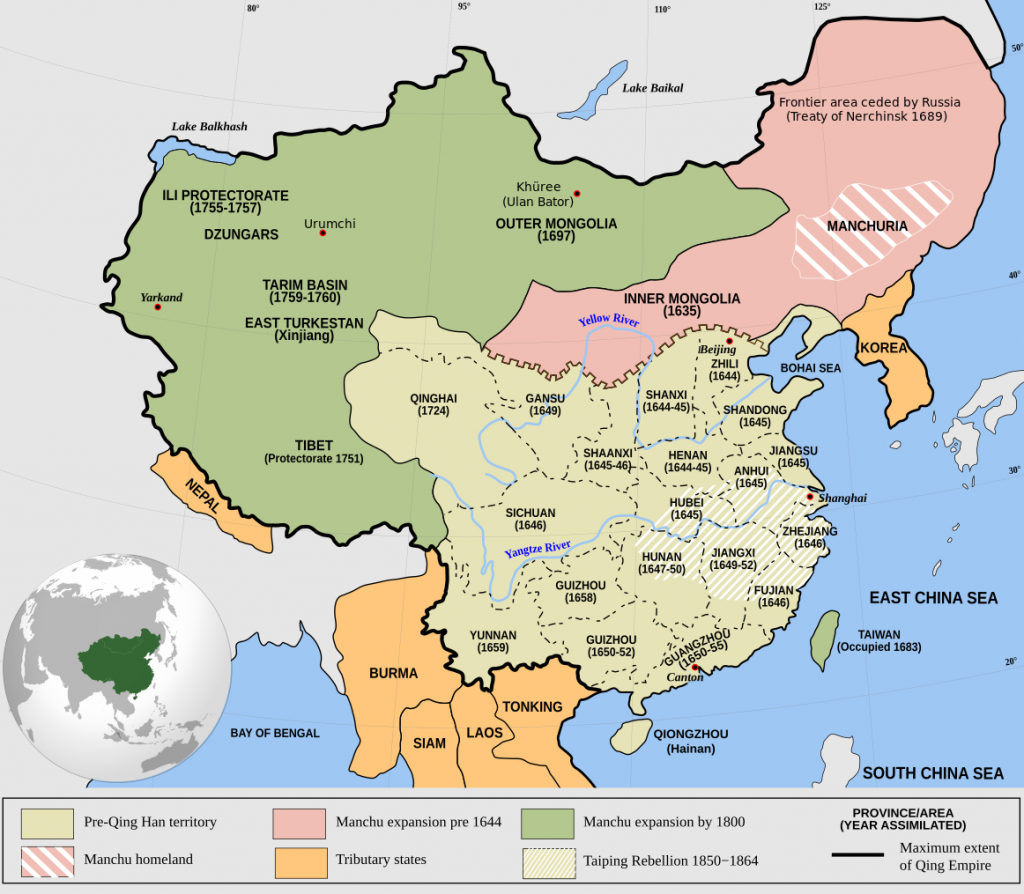
The transition from Ming to Qing, Ming–Qing transition, or Manchu invasion of China from 1618 to 1683 saw the transition between two major dynasties in Chinese history. It was the decades-long conflict between the emergent Qing dynasty (清朝), the incumbent Ming dynasty (明朝), and several smaller factions in China (like the Shun dynasty 順朝 and Xi dynasty 西朝). It ended with the rise of the Qing, and the fall of the Ming and other factions.
The Qing dynasty, officially the Great Qing ([tɕʰíŋ]), was the last dynasty in the imperial history of China. It was established in 1636, and ruled China proper from 1644 to 1912, with a brief restoration in 1917. It was preceded by the Ming dynasty and succeeded by the Republic of China.
The Qing dynasty was China’s last dynasty, and it lasted from 1644-1912. This period under the Qing dynasty constructed and built upon the foundations for modern China, and its coming to power in 1644 marked the beginning of modern China. However, its demise in 1912 also saw the start of a turbulent modern history.
The Qing dynasty’s eventual rise to power in 1644 was a gradual process that lasted over eighty years. It began with a coalition of peoples called the Manchus (a combination of the Jurchen and the Mongols) who were led by Nurhaci. The taking of Ming cities by the Manchus from 1625 onwards allowed them to gain a foothold into the empire, and would make the transition from Ming to Qing much easier. Furthermore, it also gave them a stable base of power within China, particularly through the capture of Shenyang.
The main features of the Qing’s reign at its peak was the lead to a period of stability and prosperity. Under the Qing there was the establishment of modern China’s territorial space, including the territories of Mongolia, Taiwan, and Tibet. Furthermore, the Qing dynasty established another characteristic of modern China: its population size. Over the course of the Qing dynasty, the population nearly tripled in size from 150,000,000 to over 450,000,000.
There was also a resurgence in the arts and sciences; new inventions such as printing productions were made, a new philosophical movement emerged called legalism, and there was an increase in the production of literature (the most famous text would be The Dream of the Red Chamber, published in 1791). Overall, the Qing dynasty saw a rebirth in Chinese culture, and contributed to developing China’s most recognisable geographical characteristics.
Therefore, the overwhelming achievements of the Qing dynasty certainly left an impact on modern China, and even Western perceptions of early modern China. For example, the Qing dynasty suppressed discontent by making all men wear the ‘Jurchen queue’ and those not wearing this hairstyle would have been executed. This was a long braided ponytail that has come to symbolise the Western perception of the ‘Chinaman’. Moreover, the Qing dynasty’s achievements cemented the geopolitical foundations of modern China.
However, it can also be argued that the Qing dynasty’s failings and its eventual collapse made more of a profound impact on China’s history. The Qing dynasty failed in foreign relations with the West (Opium Wars 1839-1860) and the Japanese (Sino-Japanese War 1834-5) and its economy eventually became unstable. Most notably, it failed to enact substantial political reform. The reforms that were made eventually lead to the creation of political parties, and thus the rise in political discontent against the dynasty itself. This all culminated in its collapse by the forced abdication of Emperor Xuantong in 1912, thus leading to the creation of a republic headed by the revolutionary Sun Yat Sen.
To conclude, the year 1644 is an important date for modern Chinese history. It saw the beginning of modern China in terms of culture, geography, and politics, and the beginnings of a unified China in its territory and culture.
Sources:
https://manchesterhistorian.com/2016/1644-ming-qing-transition-in-china/